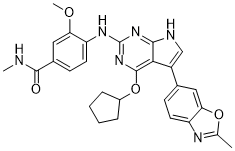Physicochemical Properties
| Molecular Formula | C28H28N6O4 |
| Molecular Weight | 512.559725761414 |
| Exact Mass | 512.217 |
| Elemental Analysis | C, 65.61; H, 5.51; N, 16.40; O, 12.49 |
| CAS # | 1618658-88-0 |
| Related CAS # | 1618658-88-0 |
| PubChem CID | 117881270 |
| Appearance | Off-white to light green solid powder |
| LogP | 5.2 |
| Hydrogen Bond Donor Count | 3 |
| Hydrogen Bond Acceptor Count | 8 |
| Rotatable Bond Count | 7 |
| Heavy Atom Count | 38 |
| Complexity | 814 |
| Defined Atom Stereocenter Count | 0 |
| InChi Key | CWJLAVRXVFHDSJ-UHFFFAOYSA-N |
| InChi Code | InChI=1S/C28H28N6O4/c1-15-31-21-10-8-16(12-23(21)37-15)19-14-30-25-24(19)27(38-18-6-4-5-7-18)34-28(33-25)32-20-11-9-17(26(35)29-2)13-22(20)36-3/h8-14,18H,4-7H2,1-3H3,(H,29,35)(H2,30,32,33,34) |
| Chemical Name | 4-[[4-cyclopentyloxy-5-(2-methyl-1,3-benzoxazol-6-yl)-7H-pyrrolo[2,3-d]pyrimidin-2-yl]amino]-3-methoxy-N-methylbenzamide |
| Synonyms | CC671; CC 671; CC-671 |
| HS Tariff Code | 2934.99.9001 |
| Storage |
Powder-20°C 3 years 4°C 2 years In solvent -80°C 6 months -20°C 1 month |
| Shipping Condition | Room temperature (This product is stable at ambient temperature for a few days during ordinary shipping and time spent in Customs) |
Biological Activity
| Targets | CLK2 (IC50 = 0.006 μM) |
| ln Vitro | CC-671 (compound 23) is a dual inhibitor of TTK protein kinase and CDC2-like kinase (CLK2), with IC50 values for TTK and CLK2 of 0.005 and 0.006 μM, respectively. Only four kinases—CLK2, CAMKK2, PIP4K22, and JNK—show cellular binding of 75% or more in HCT-116 cell lysates treated with CC-671 at 3 μM for 1 hour[1]. |
| ln Vivo | CC-671 (compound 23) exhibits a noteworthy 71% tumor growth inhibition (TGI) (vehicle-treated/vehicle) ×100%) at doses of 10 and 20 mg/kg when administered on a once-every-three-day (q3d) basis. Body weight loss (BWL) was greater in the group treated with CC-671 (20 mg/kg) than in the group treated with 10 mg/kg (17% vs. 5%)[1]. |
| Enzyme Assay | Compound 23 (CC-671) kinase selectivity profile is evaluated. The CC-671 concentration is maintained at 3 μM throughout the screen. Kinase binding assays are used to quantify the TTK binding affinity. The ATP-competitive kinase inhibitor scaffold, which is proprietary and labeled with Alexa Fluor 647, is the basis for the kinase binding assays[1]. |
| Animal Protocol | Subcutaneous injection of 5×106 Cal-51 cells is administered to female SCID mice. Randomized mice bearing 125 mm3 tumors are administered CC-671 (compound 23) intravenously at different intervals and doses (n=8–10/group). For the course of the investigation, tumors are measured twice a week. Tumor volumes are computed by measuring each tumor's long and short axes in millimeters with a digital caliper[1]. |
| References |
[1]. The Discovery of a Dual TTK Protein Kinase/CDC2-Like Kinase (CLK2) Inhibitor for the Treatmentof Triple Negative Breast Cancer Initiated from a Phenotypic Screen. J Med Chem. 2017 Nov 9;60(21):8989-9002. |
Solubility Data
| Solubility (In Vitro) | DMSO: ≥ 60 mg/mL (~117.1 mM) |
| Solubility (In Vivo) |
Solubility in Formulation 1: ≥ 2.08 mg/mL (4.06 mM) (saturation unknown) in 10% DMSO + 40% PEG300 + 5% Tween80 + 45% Saline (add these co-solvents sequentially from left to right, and one by one), clear solution. For example, if 1 mL of working solution is to be prepared, you can add 100 μL of 20.8 mg/mL clear DMSO stock solution to 400 μL PEG300 and mix evenly; then add 50 μL Tween-80 to the above solution and mix evenly; then add 450 μL normal saline to adjust the volume to 1 mL. Preparation of saline: Dissolve 0.9 g of sodium chloride in 100 mL ddH₂ O to obtain a clear solution. Solubility in Formulation 2: 2.08 mg/mL (4.06 mM) in 10% DMSO + 90% (20% SBE-β-CD in Saline) (add these co-solvents sequentially from left to right, and one by one), suspension solution; with ultrasonication. For example, if 1 mL of working solution is to be prepared, you can add 100 μL of 20.8 mg/mL clear DMSO stock solution to 900 μL of 20% SBE-β-CD physiological saline solution and mix evenly. Preparation of 20% SBE-β-CD in Saline (4°C,1 week): Dissolve 2 g SBE-β-CD in 10 mL saline to obtain a clear solution. Solubility in Formulation 3: 2.08 mg/mL (4.06 mM) in 10% DMSO + 90% Corn Oil (add these co-solvents sequentially from left to right, and one by one), clear solution. For example, if 1 mL of working solution is to be prepared, you can add 100 μL of 20.8 mg/mL clear DMSO stock solution to 900 μL of corn oil and mix evenly. (Please use freshly prepared in vivo formulations for optimal results.) |
| Preparing Stock Solutions | 1 mg | 5 mg | 10 mg | |
| 1 mM | 1.9510 mL | 9.7550 mL | 19.5099 mL | |
| 5 mM | 0.3902 mL | 1.9510 mL | 3.9020 mL | |
| 10 mM | 0.1951 mL | 0.9755 mL | 1.9510 mL |
